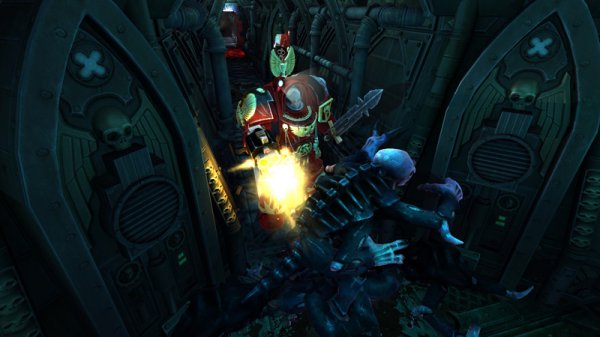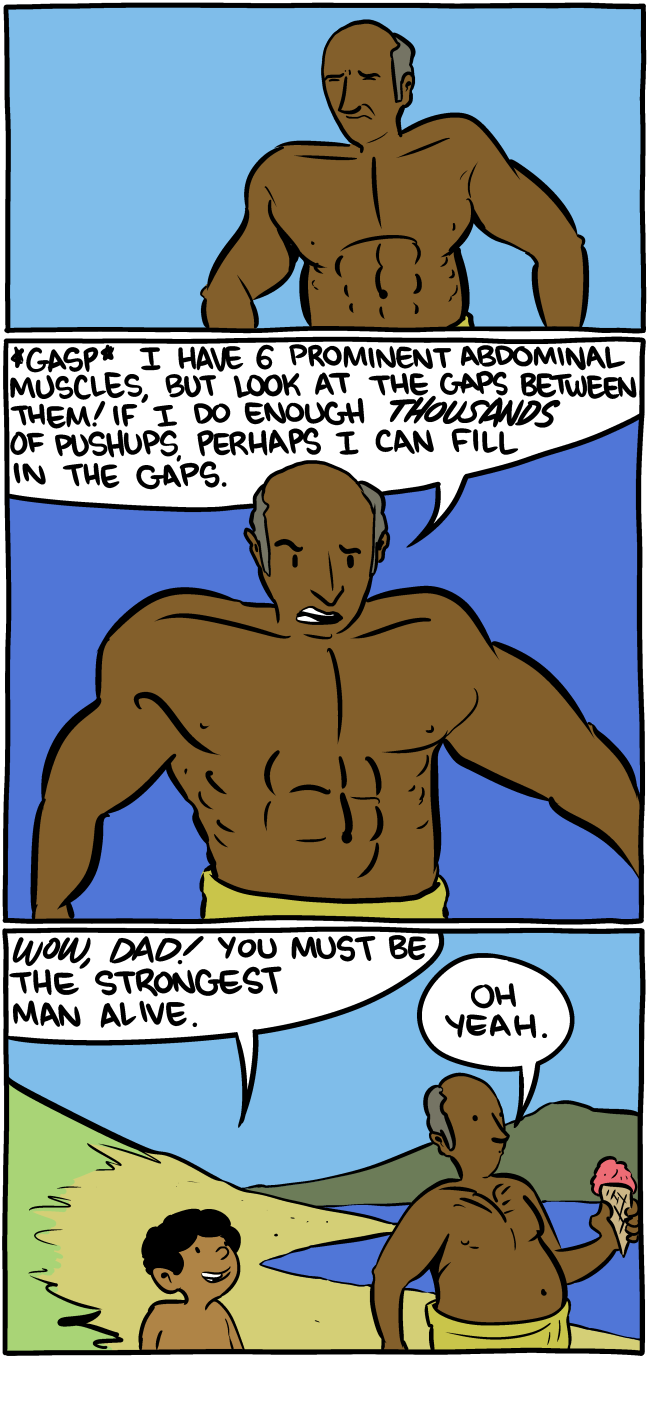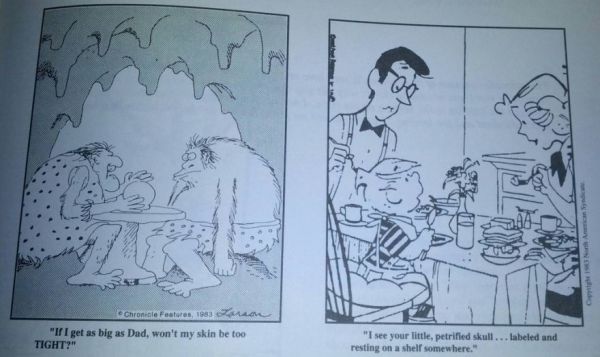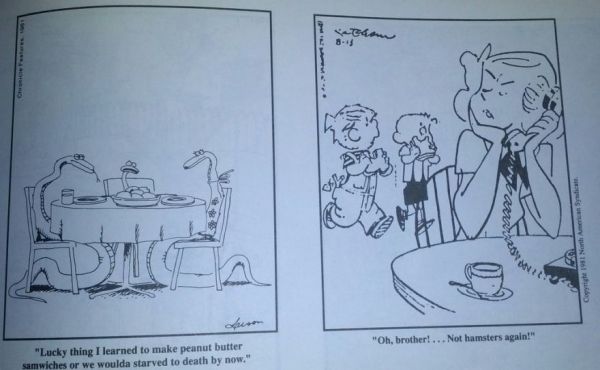
Illusionary
Shared posts
Wot I Think: Space Hulk

Emperor, forgive me for what I’m about to write. It’s me, Rab Florence. You know I love Space Hulk. You know I have every edition of the game. You know I am pure.
But it’s three in the morning, and I’ve been playing Space Hulk on PC for six hours, and that’s more than enough. It’s been a painful, heartbreaking six hours, and the thought of a seventh is unbearable. Let me tell you why.
(more…)
So You Think You Can Fart - Dance and the world dances with you. Poot and you poot alone. [So You Think You Can Dance]
Auditions wreak havoc on contestants' bodies...and gastrointestinal systems, too, as our supercut of So You Think You Can Dance's auditions proves. Room-service beans: the unsilent killer.
[ NOTE: If your RSS reader does not show a video here, please click here to view it on Previously.TV. ]So You Think You Can Fart appeared first on Previously.TV
A Newspaper Accidentally Switched the Captions for The Far Side and Dennis the Menace. Twice.
Now Is The Time To Buy The Mad Max And Terminator Blu-ray Box Sets
Amazon’s Gold Box deal today is both The Mad Max trilogy Blu-ray box set and the Terminator “Anthology” Blu-ray box set.
I’m not sure I’d heard the Terminator films referred to as an anthology until this set was released but it kind of makes sense I suppose and it certainly sounds better than quadrilogy.
The Mad Max Trilogy set is currently $27.99, which is 44% off the rrp of $49.99. The first two Mad Max films really are fantastic, with some truly incredible stunt work. The discs for the first two both have audio commentaries, the first with various members of the crew discussing the film and the second with George Miller and cinematographer Dean Semler. The third film doesn’t really live up to the first two but it’s still a lot of fun. That disc unfortunately has no extras.
The Mad Max discs all boast very decent transfers and while I haven’t verified the coding myself reportedly the first disc is locked to region A but the other two are not locked.
The Terminator Blu-ray set is currently $24.99, 50% off the rrp of $49.99. The ratio of good to bad is not quite as good in this set as it is with the Mad Max films but the first two films are both excellent, but for very different reasons.
The second Terminator film is a particularly impressive technical achievement and will be film that will almost certainly be referenced as an important example of special effects work for many years.
The Terminator set comes with a number of special features, with the second film probably being the best of the set with two different cuts of the film and two commentaries, one with James Cameron and writer William Wisher and the other with a selection of the crew.
As far as I can tell all of the Blu-rays in this Terminator set are locked to region A.
If you want to pick these up I suggest you hurry as the Gold Box deals only last for one day.
Now Is The Time To Buy The Mad Max And Terminator Blu-ray Box Sets
Awesome Muscle Car Wonder Woman DC Nation Shorts Now...
Awesome Muscle Car Wonder Woman DC Nation Shorts Now Online
Robert Valley’s Wonder Woman shorts for DC Nation are now all up on YouTube giving you 3 minutes plus of footage this year by someone who doesn’t think Wonder Woman is “tricky.”
Test how old your ears are with this hearing test
Posters For Movies You Might Remember Troy McClure From
Enable JavaScript to check out our fancy slideshow.
He’s Troy McClure. You might remember him from such shows as The Simpsons, where his absurd filmographic history was a running gag every time an educational video was watched or an infomercial had. Now the blog You Might Remember Me From… has gone back and made movie posters and VHS covers from some of McClure’s greatest Simpson’s hits. Check out our favorites in this gallery, and remember the acting exploits of Springfield’s greatest thespian.
(via Neatorama and You Might Remember Me From…)
Are you following The Mary Sue on Twitter, Facebook, Tumblr, Pinterest, & Google +?
Testicle-eating fish spotted in Swedish/Danish waters

Experts from the Danish National History Museum have warned that pacus -- a relative of the piranha -- have been spotted in the Danish/Swedish Øresund channel. The pacu has been known to bite swimmers, and have been known to attack men's testicles, because "testicles sit nicely in their mouth." So men are being cautioned to avoid nude swimming in the channel, though the museum's Henrik Carl stresses that the risk is not very high, in the grand scheme of things: "You're more likely to drown than get your nuts bitten off."
“The pacu is not normally dangerous to people but it has quite a serious bite, there have been incidents in other countries, such as Papua New Guinea, where some men have had their testicles bitten off,” said Henrik Carl, a fish expert at the Danish museum, speaking to The Local, an English-language newspaper in Sweden.
“They bite because they're hungry, and testicles sit nicely in their mouth,” he told the paper.
Carl was keen to tell swimmers not to worry too much. “You're more likely to drown than get your nuts bitten off,” he said.
Men in Sweden warned after sighting of testicle-eating fish [Nick Renaud-Komiya/The Independent]
(via JWZ)
(Image: Rosarinagazo/Wikimedia, CC BY-SA) ![]()
20 People Shot With BB Guns At LG G2 Promotional Event
Read more of this story at Slashdot.
Error of Omission: 50-Floor Skyscraper Lacking an Elevator

Twin towers raising up the existing skyline and joined at the top – these were supposed to be a sign of recovery in a city and country ravaged by the global financial collapse. Instead, the Intempo building in Spain has become a stark standing symbol of incompetence. Consider, for instance, the following farcical architectural accident: it was not built to house an elevator actually able to climb the structure, which is already over 500 feet tall.

As Jamie Condliffe summarizes on Gizmodo (images via IntempoBenidorm), the rising scope of the building was in part “a function of the greed surrounding the project. Initially designed to be a mere 20 stories tall, the developers got over-excited and pushed the height way up: now it boasts 47 stories, and will include 269 homes. But … original design obviously included specifications for an elevator big enough for a 20-story building.”

As a result, the shaft space and room for lifts, motors, cable and other equipment was significantly under-designed, leaving nearly thirty stories (maybe more, depending on the final height) of condominiums that would be walking-access only if the structure were finished as currently planned.

Thanks to bad banks going under, corruption surrounding the construction itself and costs of materials, the entire process has been plagued with problems and setbacks almost since it began. At different points, the builder went without pay, workers walked off the job thanks to poor safety conditions and interruptions have delayed completion time and time again. On the financial side, from Economia: “The project is burdened by allegations of fraud, liens and claims from customers and suppliers.” The absence of spatial accommodation for a working elevator is in some ways simply the symbolic cherry on top – except to get to that cherry, you would need to walk up dozens of flights of stairs.




[ By WebUrbanist in Architecture & Houses & Residential. ]
[ WebUrbanist | Archives | Galleries | Privacy | TOS ]
Amazon Founder Says He Clicked on Washington Post by Mistake
Andy Borowitz:
“I guess I was just kind of browsing through their website and not paying close attention to what I was doing,” he said. “No way did I intend to buy anything.”
Mr. Bezos said he had been oblivious to his online shopping error until earlier today, when he saw an unusual charge for two hundred and fifty million dollars on his American Express statement.
PAR The Cut: The lead writer of Borderlands 2 explains why he loves Papers, Please
Why There Should Never, Ever Be a He-Man Movie

I am a He-Man fan. A huge one. The amount of money I’ve spent on Masters of the Universe toys, new and old, is frankly tragic. Of all my favorate franchises — Star Wars, Game of Thrones, Saga, Avengers, whatever — it is by far my favorite. So please understand I’m not saying this lightly: There should never, ever be Masters of the Universe movie. Ever.
These photos of Shanghai's cityscape were taken just 26 years apart
Google search suggestions by country
Google search suggestions have transformed into a never-ending source of entertainment and a candid peek into what people look for in the world. We've seen insecurities change with age and stereotypes of states in the US. Noah Veltman banked on the locality of suggestions for a country-specific view of the world. He shows suggestions for the same query for the United States, Canada, the United Kingdom, Australia, and New Zealand.
For example, a search for "why is America" in each country depicts stereotypes and national curiosities about why America is so fat, rich, and better than Canada. Scroll down and you see suggestions for "how to", "why is there", and "why does everyone" which interestingly shows many of the same wonderings.
Now if you'll excuse me, I have to go eat bacon and swim in my pool of gold coins while I browse through my vastly superior Netflix selection.
Fast Food Workers Gone Wild
What do you get when you combine young fast food employees with poor impulse control and low wages so they don't care about keeping their jobs? Fast food shenanigans that's pure Internet gold.
Here are a few examples of fast food workers gone wild (before they got fired anyhow) ... now, who wants to go grab a burger?
Burger King Bun Bed

Need a quick nap? This Japanese Burger King employee decided to make a comfy bed out of burger buns. But we wonder: what the heck is in that bucket?
The Taco Bell Taco-Licker

It's one thing to lick a stack of taco shells, it's another thing to lick a stack of taco shells, then post the photo to Taco Bell's official Facebook page! That sure got management's attention, who got the last lick by firing the taco-licker.
Feet-in-Lettuce

Lettuce is the only thing healthy in that burger, right? Well ... "lettuce" hope that our leafy greens don't come from the this batch.
Wheez the Frosty

Cups? We don't need no stinkin' cups at Wendy's, as this employee demonstrates his superior wheezing-the-juice technique with the Frosty machine.
Licking the Mashed Potato

Apparently, this employee didn't get the KFC memo. It's finger lickin' good, NOT lickin' the mashed potato.
Not the Footlong You're Expecting

That's not the (half) footlong you're probably expecting from this Subway Sandwich Artist, who not only put his privates on the bread, but also froze his pee for some inexplicable reason.
Just a Fast (Food) Bath

All that shenanigans sure can make you dirty. Time for a bath ... in the fast food restaurant's industrial size sink!
Note: All of the employees listed above have been (rightfully) fired from their jobs, so let's not think about doing any of these, mmkay?
August 03, 2013

A great big thankyou to everyone who helped make GaymerX happen. Please come by tomorrow where I'll be signing at 3! And come by anyway to have a good time.
Fisherman cuts self out of shark, Sharknado-style

A fisherman from Victoria, Australia, climbed inside the shark he had captured, poked an arm through its lifeless gills, and staged this incredible shot for posterity. From Perth Now:
First reported by 3AW, a radio station in Australia, the fisherman isn't named. But show host Ross Stevenson declared it their "photo of the year" on the spot. [via Gawker]"An American couple have turned up at the Metung Hotel to see this photo and their immediate response from the wife was 'Did he survive!?'." The fisherman was standing right behind her at the time. Presumably, his answer was "yes".
"Gynaecology for Anxious Patients" & Puppetology (1973)
Puppets and marionettes were frequently used in 1970s healthcare. For example, at Scarfolk Hospital & Confectioners, electro-shock therapy was administered by ventriloquist dummies. Even Scarfolk Council's very own Barbara, the omphalophobic hand puppet, performed amateur lobotomies on disobedient children and undesirable tourists in her weekend hobby group.
Bi-weekly prostate examinations were performed by a wooden Pinocchio puppet who initiated the procedure by telling a series of lies (whilst attached to a polygraph machine to ensure a rigorous, productive examination).
If Pinocchio discovered anything to be concerned about he would withdraw and squeal: "We've found a nasty one, Jiminy Cricket!"*
Warren Ellis: "Lich-House," a short story

Follow us on Twitter
Lich-House
By Warren Ellis

"Binary Predator" by Daniel Martin Diaz
Introduction
In 2013 at Institute for the Future, the non-profit forecasting thinktank where I'm a researcher, we explored what we're calling the Coming Age of Networked Matter. Over the next few decades, a confluence of breakthroughs in physics, engineering, biology, computation, and complexity science will give us new lenses to observe the wondrous interconnections surrounding us and within us. In the future we’re moving toward, we won’t only observe complex systems, we’ll also modify and even create them in vivo and with purpose. It will be an era of huge possibility, daunting pitfalls, and high weirdness. To help make this future tangible, we commissioned some of our favorite writers of speculative fiction -- Cory Doctorow, Rudy Rucker, Ramez Naam, Bruce Sterling, Madeline Ashby, and Warren Ellis -- to write short stories tied to our research theme. The anthology, titled An Aura of Familiarity: Visions from the Coming Age of Networked Matter, contains six stories all released under a Creative Commons license. The accompanying art is by Daniel Martin Diaz. We are thrilled to premier these stories on Boing Boing. At IFTF's site, you can watch an animated author interview and find out how to win a limited edition print copy of the book and a t-shirt. In August, the entire book will be available as a free PDF at IFTF.org. -- David Pescovitz
The white room is bleeding to death.
A white vestibule, with white floors and white walls and a lit white ceiling. The only other color is red. A crack in one wall, exposing a raw fistula in the bioelectric packeting. Blood leaks from the hole, down three inches of slick white wall, to pool on the floor. A broken heart in the interstitial net of veins and wires that makes our houses live and breathe.
Somebody has murdered the house.
* * *
Whoever it is, they are disguised in different blood. human blood is net- worked. The intruder is wearing nine pints of a“dumb” perfluorocarbon emulsion, highly oxygenated. The intruder’s clothing is similarly stupid. Scavenged materials, hand sewn. Its security measures are dead, stabbed by the intruder, and it is bleeding out, but it can still see.
The house is not intelligent in any human sense. It has attempted to report its wound to the network. It does not understand that some form of help will be on the way. It simply reports, and logs the digital result of that report. In this instance, it has written that the local grid appears unavailable. This is not because of the hole in its wall but due to an environmental denial-of-service attack. The street, and much of its flora and fauna, are flickering on and offline. The house has begun to dump the record of its dying gaze into the storage vault in its foundations.
The house will die slowly. It will hold on for as long as it can and record as much as it can.
The house didn’t recognize anyone at the door until it was too late. Even now, with the intruder moving through the vestibule into the hallway corridor, the house is having difficulty gathering data on the figure. The intruder’s head and hands are covered in metamaterial sheathing, studded with ultraviolet LEDs.
The house, with its throat cut, cannot shout an alarm. Outside, it is causing the flowers in the yard to change their colors, petals turning fluorescent orange. This is the most it can do to signal a home invasion at this time. Inside, it grows more limited by the moment. The hallway is already colder. As the temperature drops, the house studies the intruder for hot spots, while pinging the outside world for a connection eighteen times a second. The house, in its chilly algorithmic way, will fight until it can no longer.
* * *
The walls of the vestibule began to pit. Its flooring had gone gray and was taking on the texture of river mud.
The hallway carpeting almost imperceptibly rotted away, revealing complex systems of runnels incised into the flooring.
The intruder was in the living room now. The television wall was showing nothing but a swirl of RGB, its screen spasming in the corners, surface rippling and twisting. The sofa and armchairs were forgetting their shapes and were unable to log in to the cloud for a reset.
The large Klimt curtains over the windows were an unnecessary affectation in the days of responsive glass. They functioned as simple still cameras, polymer lenses and plastic batteries in the weave, with a simple telephony aerial that’d get an image file out over the cellular air. Within a few minutes, the occupant’s security service would receive a JPG of a figure apparently without face or hands, even these basic lenses entirely defeated by the intruder’s imaging countermeasures.
The hot spots on the figure were now showing the house how the intruder dressed. This led the house to discover two epithelial cells on the cuff of the left glove. As the intruder stepped back into the hallway, the house was able to ping them, to no end. However, a third, longer epithelial was located in the back seam of the intruder’s hood. This scrap of skin, caught in the seal and no more than three millimeters across, was networked. The hood had at the very least been handled by someone whose employment contractually required total tracking. When the house stroked it with a gentle wave of radio energy, it gave up its name and number. The house stored that in the hard vault. If the eDoS attack hadn’t been in effect, the house may well have been able to track that cell’s digital spoor across the network and into a human operating system. In serious circumstances, law enforcement decisioning systems could select cerebromedullospinal disconnection for that human to prevent flight previous to questioning.
Decisioning systems were not artificial intelligence. They were calculations of the network.
Not a concern for the human intruder in the house, of course, even if the street had been on the grid. The human in the house was aggressively non-networked.
The human occupant slept on. The house was unable to warn her. It was possible that the maintenance-related empathetic simulators in the occupant’s body, which provided a general alert to failures in the house system, might eventually wake the occupant, but their effect was extremely low level so as not to impair the occupant’s own ability to function. After a long day, a digitally generated sense of unease usually wasn’t enough to rouse anyone from a night’s sleep.
Power circuits were starting to give up now. The dining table had responded to a connectivity interruption of more than a moment by compacting itself. The dining room itself, noticing that its lighting was strobing, shut its light fittings off entirely so as not to disturb any occupants.
That room was empty. The intruder was in the kitchen. The electricity was already dead here. The fridge had gone to its power-cut setting, busy battery-run hands working inside it to strip and crush the foodstuffs within by animal and vegetable and order of expiration date. The packages were trying to signal their suppliers, with no luck.
The intruder walked back and began to ascend the stairwell. Her steps were just a little louder now because all the downstairs flooring was hard and resonant, its claddings wished away by the house. The vestibule walls were rotting heavily now, sliding from their frames and collapsing into thick, knobby cones before falling to the floor and deliquescing into the runnels that the mud had evanesced to uncover.
The intruder stepped onto the edges of each stair, as the strip of decorative carpet pinned down the middle of the staircase unwove itself, its soft strands of neutrally toned programmable matter breaking down into wisps of biodegradable anti-bacterial mist. The stairwell walls were dripping and pattering gently, and the trickle of liquid along the runnels and down into the containment bins under the house was getting louder. At this point in the process, the slow death of the house sounded not unlike some ambient relaxation soundfile.
At the top of the stairs, the intruder drew a weapon. The house, still with eyes to see through, zeroed in on it. It was a handgun. An offline handgun, and therefore illegal in this particular geographical location. The house was unable to consult a library about the weapon. Not that this would have mattered or made any difference. The weapon was actually a Colt M1911A1, a semi- automatic pistol designed in 1924 and used deep into the twenty- first century by the FBI and various special operations forces. There was nothing clever or beautiful about it in a modern sense. It had none of the immensely useful and impressive innovations of the contemporary world. It just killed people.
The handgun was in fact so simple that the house, in an ordinary moment, had more than a dozen ways to counter it. In the case of semi-automatic fire, the house could even have caused air molecules to clump into socks of matter dense enough to net the bullets before they reached a target. None of this could happen.
Up here, there were only three rooms. At the back of the house, there was the bathroom, darkened. Next, a second bedroom used as a storeroom, dark and its door wide open. At the front of the house was the master bedroom, wide and spacious, elegantly designed. The occupant preferred to go to bed with the door open just a little. In the first couple of weeks of the occupancy, the house had studied the fractions of that partly opened door and calculated an average. Since then, the house had taken care of that door. The house watched, and managed, the smallest parts of its anthropic usage. It made the occupant feel like her house liked her: that her house could feel and think.
The intruder entered the room, damp shoes on a hardwood floor. This was not a pistol that needed to be cocked. The safety, oiled and well cared for, slid silently under the intruder’s thumb.
The wall between the dining room and the kitchen let go in a rush, a sudden river of wet matter hitting the flooring like a mudslide.
The occupant woke just as the intruder took another step into the room. The combination of sound and motion detection gave the occupant a jolt.
The intruder raised her weapon. The occupant slapped her bedsheet. The matter of the sheet remembered the strike pattern and collimated into a hard wide blade of something strong enough to take the impact of a bullet. It was purchased as a non- networked, last-ditch protective measure. It was often awkward and annoying. Just blearily groping around in bed for a dropped phone—some people still had cause for secure handset phones, some people had issues with soft eye cauls—could set the thing off, instancing a bedside tableful of things on the floor or a sharp smack in the throat. She brought her knees up to prop the sheet as she twisted around to pull her own handgun from under her pillow. The house’s security systems, like the gun, were part and parcel of her particular form of employment.
The M1911A1 went off like a thunderclap. The bullet shattered on the sheet. The intruder fired again—the house could still see, and added its calculation of gunshot residue volume to its rolling report—and the sheet took the second bullet but cracked into three pieces a second afterward. The occupant already had her gun. She had closed her eyes during both gun flashes, and her night vision was relatively intact. She brought the gun up with a well-practiced straight-thumbs combat grip.
The gun was networked. Modern firearms were capable of many wonderful things. A networked gun watched and listened to the world around it constantly in a variety of manners, consulting many different behavioral databases every second. Its own decisioning systems could select modes of response to a threat and even lock out lethal operations in non-lethal circumstances. It could kick out a nanosecond high-voltage electrical pulse over the air that would render the human target relatively safely unconscious for five to ten minutes. It could dial the impact yield of an explosive bullet down in accordance with information continuing to be revealed about the target while that bullet was in flight, turning a fatality into a nominally survivable wound. Or otherwise. Some state-of- the-art handguns used networked ammunition that could change their shapes in similar manner, flattening out for a stun strike or screwing into a hard point for armor penetration. Given the times, the disruptive nature of any informational technology and the sheer hot hellish tangle of the societal condition, networked firearms were strange legal miracles.
And when the network was down due to a DoS attack, they simply didn’t work at all.
The trigger didn’t even squeeze. The gun refused to operate because it couldn’t find the network that granted it legality of use. It locked up.
The intruder put two bullets through the occupant’s heart and two through the occupant’s forehead.
The bed, dumbly, began to attempt to soak up the sudden spill of liquid.
The air scrubbers had already failed, and so bitter clouds of nitrate and soot circulated around the room. The house logged this, too. Gunshot residue was still almost impossible to wash off by conventional means.
The intruder turned at the acid, jagged sound of water pipes being withdrawn from the bathroom.
The floor scarred with runnels and tilted two degrees toward the staircase. A gentle camber to facilitate drainage. The bed shuddered, trying to process the corpse, and then died itself, forgetting its memoryforming and sagging like a euthanized lapdog. The walls began to bleed from ten thousand tiny pinpricks.
The intruder had to wait for a moment longer to ensure her target was irretrievably dead. The occupant’s onboard system was prevented by the eDoS from uploading basic audiovisual memory take, and the headshots should have destroyed her offline storage as well as her brain, but internal medical operations were tricky things these days. The heart was still twitching weakly, little red oil spills bubbling and leaking across the desert of the occupant’s skin. The flesh did not knit over the bullet holes. The eyes did not judder with the telltale of secondary neural processing. The redness pooled and was still. The networked attributes inside her, still running off piezoelectric stores, would have been screaming for help. People like this had two deaths. The computing elements inside them took several minutes longer to go the way of the flesh. Right now, they were ghosts rattling inside a locked box of meat.
The intruder went quickly to the upstairs corridor, replacing the gun in her jacket. Along the hall, the bathroom was tearing itself down. A slamming of hard polymer doors indicated that the storage room was being sealed. The ceiling crackled, taking on a texture like wicker overhead. The house was gathering itself for its death throes. All the floors were cantered, the melting walls running through the channels underfoot toward the staircase. The stairs themselves had flipped in the last minute, reconfigured into a smooth ramp to ease the passage of the house’s liquefying carcass.
The ceiling convulsed and tore open, releasing a torrent of fluid down into the corridor, splashing the intruder and making the floor even more dangerously slick. Even the intruder, at this point, imagined the dying house laughing at her, spitting its hateful revenge in its last extremity. Looking up in search of further dank waterfalls, she imagined for a moment that she could see the night sky through the ceiling. Five seconds later, she realized that that was exactly what she was seeing. The house was coming down.
The intruder attempted to make her way down the ramp in a slow and controlled manner, one hand on the wall and the other on the bannister. The hand on the wall sank in by an inch or so. It was like trying to find purchase in a vat of warm oatmeal. The bannister began to break up in her grip, damp compost in her palm. The sound of running water was starting to become deafening.
The intruder crouched like a skier and, fingertips on the wall for guidance, slid down the ramp in fits and starts, desperate not to fall backward or pitch over forward into the ground floor face- first. If nothing else, that could have torn the mask, and she had to consider that the house might yet have an eye working.
Foam jetted from the house’s exposed bones. It was time for the structure’s final teardown.
There was a sudden, awful explosion of noise, and a large gray box smashed through the downstairs ceiling and through the hallway floor. It was the storage room, retaining the occupant’s goods and deploying them down into the foundation unit below the house for safekeeping. The place was heaving like a stabbed animal scrabbling for breath. The foam was dissolving the house’s hard superstructure.
It would shortly begin to destroy the intruder’s shoes and any other clothing it hit. It was also destroying the occupant’s body.
The intruder drew the M1911A1 again and tossed it on the floor, up against the corner of the living room doorway. The foam would tear down the gun as surely as it would the rest of the hard superstructure, reducing it to a slurry of its consistent minerals. Upstairs, the occupant’s own mineral content was being scavenged from her corpse and sequestered in the foundation unit for later exploitation. The intruder waited as long as she dared to see some of the foam touch the pistol and to witness the violent chemical reaction it touched off. She turned her back on the fizzing, fracturing iron and headed for the vestibule.
The house was entirely blind now and could only hear the intruder, splashing through its rendered fats, moving through the hollows left by its drained marrow with all speed toward its slack mouth.
The intruder tossed the knife she’d used to kill the house on the vestibule floor. It began to smoke and pucker as the house’s liquids washed over it. The intruder did not slow down, because she could feel the soles of her shoes becoming soft and tacky. They’d been coated in materials resistant to home teardowns, but the environment was intense and she’d been dawdling in comparison to the mission’s timed test runs.
The house died as the intruder stepped through the front door.
The intruder took note of the orange blooms outside, recognizing them for the silent alert they were intended as. No one else
seemed to have paid them any attention: the locals were either asleep or shouting and hitting things to make their network connections come back. She figured she had possibly one more minute before the house made itself impossible to ignore. She turned right and walked quickly through the dark, listening to the air. The eDoS was still in effect. There were no drones in flight. She tugged the metamaterial mask off and then peeled off the gloves, stuffing them inside the hood and pushing the whole mass of fabric into a pocket. Everything she was wearing would have to be destroyed, but right now there was no point in prioritizing anything. She was concerned about the shoes tracking muck and corroded detritus down the street, but there was very little she could do about that without discarding the shoes right there in the gutter, which created its own problems.
So she walked on to the end of the street, running her fingers through her hair to try and get rid of the matting that wearing the mask had caused. As she turned the corner, the house filled in its own grave.
The whole structure collapsed down into foam and gel. With a crackle she could hear at the street corner, the ground-floor surface mosaic’d itself. Thousands of tiny metal cubes separated with clacks, turned themselves into wafers, inverted themselves, and slotted themselves down into the foundation unit. Every last drop of moisture from the liquefaction of the house sucked down into the unit’s vats. Where the house had stood there was now just a plot, a section of green garden behind a smooth dark square metal surface that glistened under the ambient glows of the night. A space like an extracted tooth in the jawbone of the living street.
She was already around the corner by the time the neighbors emerged from their homes to stare at the deleted house.
Within another minute, she’d made it to the next street, where her ride awaited, her driver sitting within her static car. The car was quite deliberately within the radius of the eDoS. When the network went down, the self-driving car stopped moving. It was the only visible car within a couple of blocks. No one was out on the street here.
Cars had surprisingly little onboard memory. They registered how many people boarded them but didn’t retain logs of, for instance, people getting out of them while they were dead in the road due to being offline. There were a great many privacy issues around cars and how they reported. This made car software porous enough, in fact, to be cheatable.
This car had already been told that tonight it had never had a passenger.
The woman who owned the car opened the door, stood, and saw the woman who’d killed the house approach. The intruder was relieved. She smiled, still brushing her hair out. Everything had gone according to plan. Now they’d wait perhaps a minute longer for the eDoS to end, the car would start, and they’d be off to their next staging post for clean-up and debrief.
The driver raised her arm. The intruder waved back. The driver shot her through the heart with a gas-fired ballistic knife. There was nothing of the modern world inside the woman who killed the house, and so she just died right there like the people of old.
The driver tossed the knife handle. It landed in the gutter by a drain and began to foam and fizz. The driver got back into the car. Within thirty seconds or so, the car came back to life and, with a simple canned apology, resumed its transportation of the driver to the next staging post, where it, too, would be murdered.
-end-
Click here to watch an animated interview with Warren Ellis about this short story.
Warren Ellis
Warren Ellis is the award-winning writer of graphic novels like Transmetropolitan, Fell, Ministry of Space, and Planetary, and the author of the “underground classic” novel Crooked Little Vein. The movie Red is based on his graphic novel of the same name, its sequel being due in summer 2013. His Gravel books are in development for film, with Tim Miller attached to direct, and his novel Gun Machine has been pre-emptively bought for television. Iron Man 3 is based on his Marvel Comics graphic novel Iron Man: Extremis. He’s also written extensively for Vice, Wired UK, and Reuters on technological and cultural matters, and is co-writing a video project called Wastelanders with Joss Whedon. Warren Ellis is currently working on another novel for Mulholland Books, and a nonfiction book about the future of the city for Farrar Giroux Straus.
More stories from
AN AURA of FAMILIARITY:
VISIONS FROM THE COMING AGE of NETWORKED MATTER
"By His Things Will You Know Him"
by Cory Doctorow
"Beyond The Coming Age of Networked Matter"
by Bruce Sterling
"Social Services"
by Madeline Ashby
"Water"
by Ramez Naam
"Apricot Lane"
by Rudy Rucker
Text © the author and licensed under a Creative Commons Attribution-NonCommercial-NoDerivs 3.0 Unported License. Artwork © Daniel Martin Diaz and used with permission. ![]()
Did you know that the Saturn V's fuel economy was 7 inches per gallon?
 An incredible fact from a fascinating new Buzz Aldrin interview: the Saturn V was only making 7 inches to the gallon at the moment of launch. Of course, the fuel economy improves dramatically when you actually take into consideration the entire distance travelled.
An incredible fact from a fascinating new Buzz Aldrin interview: the Saturn V was only making 7 inches to the gallon at the moment of launch. Of course, the fuel economy improves dramatically when you actually take into consideration the entire distance travelled.
Zod Kitchen

You are the one they call homeowner? I see you are practiced in working in the kitchen. Rise before Zod. Now, kneel before Zod ... in this beautifully appointed kitchen filled with modern conveniences.
Zod should know. He's been designing kitchens for 30 of your Earth years. And in that time, Zod has developed a reputation for quality service and superior workmanship at a price to suit any budget.
Hit play or go to Link [YouTube] to watch this bit of comedy by Shaun Micallef of Newstopia - via Boing Boing





























